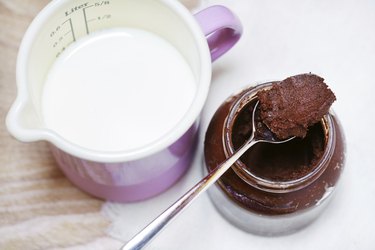
Unlike cooking, baking is more of a science that relies on the mix of certain ingredients in the right proportions to get the best results. The purpose of milk in baking is varied and may depend on what you're baking.
Tip
Milk performs many functions in your baked goods. It serves as a source of liquid to hydrate the dry ingredients, adds flavor, supports browning and softens texture.
Video of the Day
Facts About Milk
Like the juice aisle, the dairy case at your local grocery store is probably filled with dozens of options, including whole milk, nonfat milk, organic milk and lactose-free milk, along with a few nondairy varieties. Despite some grumblings about whether humans should be drinking cow's milk or not, the USDA says that milk is a good source of calcium, potassium, vitamin D and protein, and you should be drinking 2 to 3 cups a day.
Video of the Day
One cup of nonfat milk has 86 calories, 8 grams of protein and meets more than 10 percent of the daily value for calcium and vitamin D and 8 percent of the daily value for potassium.
Calcium is the most abundant mineral in your body, and 99 percent of the mineral is found in your bones and teeth, according to the National Institutes of Health, where it supports structure and function. Dairy is the primary source of calcium in the American diet, notes the USDA, and drinking 3 cups a day can improve bone mass.
When it comes to milk and health, the USDA also recommends you stick with nonfat and low-fat options. Whole milk and other high-fat dairy foods, such as cheese and full-fat yogurt, are high in saturated fat and may increase cholesterol levels.
In baking, your recipe may specify whether you should use whole or nonfat milk. However, you may want to do away with the full cream milk for baking and use the lower fat or nonfat options for better health.
Purpose of Milk in Baking
The purpose of milk in baking may depend on your recipe. In general, milk serves as a liquid to moisten your dry ingredients, dissolve sugar and activate gluten, according to the Cooperative Extension at the University of Kentucky. This not only improves the texture of your baked good, but also hydrates your proteins and starches as well as your leavening agents, which initiates the chemical reactions that change the structure and texture of your batter or dough.
The function of milk in muffins and other baked goods has much to do with its nutrient content. For example, the carbohydrates in the nonfat milk used in the LIVESTRONG.com recipe Pumpkin Morning Muffins adds a touch of natural sweetness and supports the browning of the muffin as it bakes. Additionally, the protein in the milk improves strength and structure of the muffin to improve tenderness of the crumb.
Milk is also used as a liquid ingredient for yeast dough recipes. The milk solids weaken the connections between the gluten proteins to create a softer bread. When using milk to dissolve yeast, Purdue University recommends warming the milk before adding the yeast and using nonfat milk instead of whole milk because the milk fat prevents the yeast from dissolving.
Milk vs. Water in Baking
If you're searching for a substitute for cow's milk due to an allergy, you may wonder about milk vs. water in baking. Both milk and water help hydrate the dry ingredients in baked goods, but without the nutrients, water may alter the texture or structure your baked good. According to Purdue University, using water in a yeast dough recipe may make your dough more sticky or prolong the time it takes for the dough to rise.
Though water may be fine in a pinch, the Allergy and Asthma Foundation of America suggests using a plant-based milk when baking. Unflavored soy milk can be used instead of cow's milk for any of your baking needs. Like cow's milk, soy milk is a good source of protein, with 6 grams per cup, and carbohydrates, which may help produce the results you're looking for.
The Allergy and Asthma Foundation of American also notes that rice milk and oat milk can be used as substitutes in baked goods. However, according to the nutrient data from the USDA, with less than 1 gram of protein per cup in the rice milk and 3 grams of protein in a cup of oat milk, they may not produce the same results as soy milk.
- USDA: ChooseMyPlate.gov: "Dairy: Nutrients and Health Benefits"
- National Health Institute: "Calcium"
- University of Lincoln-Nebraska: "Functions of Baking Ingredients"
- Cooperative Extension University of Kentucky: "Quick Breads"
- Purdue University: "Yeast Dough"
- Allergy and Asthma Foundation of America: "Cooking and Baking Without Milk Ingredients"
- USDA: "Soy Milk"
- USDA: "Rice Milk"
- USDA: "Original Oat Oatmilk, Original"